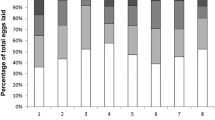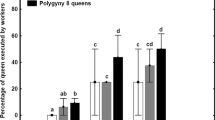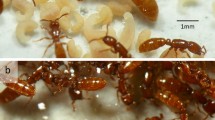Abstract
We report here the first case of queen dimorphism in a ponerine ant species. A total of 550 colonies of the Neotropical ponerine ant Ectatomma ruidum, from two natural populations in southeastern Mexico, were investigated for polymorphism and reproductive function within the queen caste. The distribution of different morphological traits (head and thorax widths, and scutum and alitrunk lengths) was shown to be bimodal. Thorax width and head width were significantly isometric for both macro- and microgynes and thorax proportions did not change with the category of the queen. Microgynes appear as an isometric reduction of the normal queens. On average, macrogynes were found to be approximately 20% larger in size and twice as heavy as microgynes (and up to three times heavier in terms of dry weight). Their wing surface was 72% greater. There was no difference between the two morphs in terms of their capacity to be inseminated and all dealate females present in natural colonies could be considered as true potentially reproductive queens whatever the class to which they belonged. Ovary size, number of ovarioles per ovary, and number of mature oocytes produced were significantly higher for macrogynes than for microgynes, but small queens were able to function as active egg-layers. However, the number of egg-laying individuals was significantly lower for this form, although egg-laying activity appeared to be independent of queen weight. Despite its markedly reduced reproductive capacity compared to macrogynes, the distribution of the microgyne form of E. ruidum in both studied populations was very broad, reaching one-third of all alate and dealate females and extending to one-third of all colonies. In 72.2% of the colonies where alate and/or dealate microgynes were present, both forms co-occurred. Fat content analysis results supported the idea that semi-claustral independent colony founding, typical for this species, would essentially be achieved by macrogynes, while microgynes would be adopted by established colonies. We argue that queen dimorphism in E. ruidum could represent an attractive alternative dispersal strategy for female sexuals. The small females may constitute an important reserve of potential reproductives at a very low energetic cost to the colony, the production of a macrogyne being about 7.5 times more costly than a microgyne. The significantly greater `wing surface/body weight' ratio of microgynes also suggests their greater capacity for dispersion. The combination of such a capacity for microgynes, along with their ability to contribute in the production of both female morphs, including the reproductively efficient macrogynes, would contribute to insuring genetic reassortment at the population level and could explain, in part, the ecological success of E. ruidum in Neotropical zones.
Similar content being viewed by others
Author information
Authors and Affiliations
Additional information
Received: 4 January 1999 / Accepted: 12 May 1999
Rights and permissions
About this article
Cite this article
Lachaud, JP., Cadena, A., Schatz, B. et al. Queen dimorphism and reproductive capacity in the ponerine ant, Ectatomma ruidum Roger. Oecologia 120, 515–523 (1999). https://doi.org/10.1007/s004420050885
Issue Date:
DOI: https://doi.org/10.1007/s004420050885




